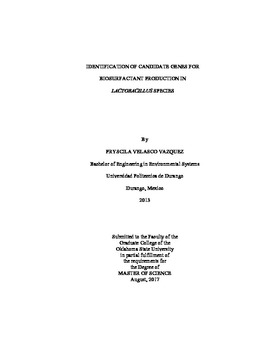| dc.description.abstract | Most bacteria are capable of forming biofilms to protect themselves from antimicrobials and other sanitation procedures. Undesired biofilm formation is a serious problem in the food and healthcare industries. Probiotic biosurfactant-producing Lactobacilli with demonstrated antimicrobial activity can be used as a deterrent of pathogenic biofilms. Currently there is no biosurfactant PCR detection method. Genes responsible for biosurfactant production in Lactobacilli are currently undiscovered.The purpose of this study is to identify candidate genes within Lactobacilli that share similarity and/or identity with known genes involved in the production of biosurfactants in other bacterial species.An in-silico study was performed through the use of the NCBI BLAST algorithms, and compared gene sequences of L. casei, L. rhamnosus, L. fermentum, L. acidophilus, L. pentosus, L. paracasei, L. helveticus, L. plantarum, L. delbrueckii, L. jensenii, L. reuteri, L. brevis (each of which has been shown to produce surlactin) with previously identified biosurfactant-producing genes of various bacteria. A set of primer sequences for a qPCR screening methodology was design to screen Lactobacillus strains.The best candidate found was selected based upon its conserved domain features and nearby ORFs; Nonribosomal peptide synthetase (NRPS) and polyketide synthetase (PKS), respectively. Similarity it was shown similarity between NRPS SrfA (that regulates production of surfactin by Bacillus subtilis), and NRPS NpsA from L. plantarum WCFS1. NRPS NpsA is 5289 amino acid long and it is consensus within seven L. plantarum strains. It is formed by five modules that are highly similar but not identical. Each module includes adenylation, condensation and thiolation domains.Therefore, further analyses of NRPS NpsA putative surlactin producer need to be performed. NRPSs can produce a variety of secondary metabolites, not only biosurfactants. The confirmation of the regulatory protein would help to design a rapid PCR screening method, using the designed primers, that may be helpful in the clinical field and food industry. | |
